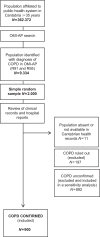Independent effect of prior exacerbation frequency and disease severity on the risk of future exacerbations of COPD: a retrospective cohort study
- PMID: 27604472
- PMCID: PMC5015428
- DOI: 10.1038/npjpcrm.2016.46
Independent effect of prior exacerbation frequency and disease severity on the risk of future exacerbations of COPD: a retrospective cohort study
Abstract
Few studies have researched the independent effect of COPD severity on the risk of future exacerbations adjusted by previous exacerbation frequency. We aimed to analyse the independent effect of COPD severity on the risk of exacerbations in the following year, and whether this effect was stronger or not than the effect of a previous history of exacerbations. We conducted a retrospective population-based cohort study including 900 patients with confirmed COPD. Exacerbation frequency was observed for the previous year and for the following year. Patients were defined as 'Frequent Exacerbator' (FE) phenotype if they suffered ⩾2 exacerbations in a year, and were categorised according to the severity of COPD (GOLD Grades 1-4). Odds ratios (ORs) were estimated by logistic regression adjusting for age, gender, smoking status, severity of COPD and being FE in the previous year. The main predictor of being FE among all grades of COPD severity was a history of frequent exacerbations in the previous year: adjusted OR 4.97; 95% confidence interval (CI) (3.54-6.97). COPD severity was associated with a higher risk of being FE: Crude OR GOLD Grade 4 3.86; 95% CI (1.50-9.93). However, this association diminished after adjusting for being FE in the previous year: adjusted OR 2.08; 95% CI (0.75-5.82). Our results support that a history of frequent exacerbations in the previous year is the most important independent predictor of exacerbations in the following year, also among the most severe COPD patients. Severity of COPD would be associated with a higher risk of exacerbations, but this effect would be partly determined by the exacerbations suffered in the previous year.
Conflict of interest statement
J.L.G-R. reports receiving consulting and/or speaking fees from Almirall, Boehringer Ingelheim, Pfizer, Astra Zeneca, Chiesi, GlaxoSmithKline, Menarini, Takeda, Teva and Ferrer y Novartis; J.M.H. reports receiving speaking fees from GlaxoSmithKline, Boehringer, Novartis, Mundipharma and y Astra Zeneca; C.B. reports receiving speaking fees from GlaxoSmithKline, Boehringer, Ferrer, Astra Zeneca and Teva, y Chiesi; M.M. reports receiving consulting and/or speaking fees from Almirall, AstraZeneca, Boehringer Ingelheim, Ferrer Group, GlaxoSmithKline, Grifols, Esteve, Pfizer, Teva, Cipla, Novartis and Gebro Pharma y Takeda. The remaning authors declare no conflict of interest.
Figures
Similar articles
-
Predictors of Hospitalized Exacerbations and Mortality in Chronic Obstructive Pulmonary Disease.PLoS One. 2016 Jun 30;11(6):e0158727. doi: 10.1371/journal.pone.0158727. eCollection 2016. PLoS One. 2016. PMID: 27362765 Free PMC article.
-
Prevalence of Influenza Vaccination in Chronic Obstructive Pulmonary Disease Patients and Impact on the Risk of Severe Exacerbations.Arch Bronconeumol. 2016 Feb;52(2):88-95. doi: 10.1016/j.arbres.2015.09.001. Epub 2015 Oct 29. Arch Bronconeumol. 2016. PMID: 26526292 English, Spanish.
-
Inflammatory biomarkers and exacerbations in chronic obstructive pulmonary disease.JAMA. 2013 Jun 12;309(22):2353-61. doi: 10.1001/jama.2013.5732. JAMA. 2013. PMID: 23757083
-
How should we define and classify exacerbations in chronic obstructive pulmonary disease?Expert Rev Respir Med. 2013 Apr;7(2 Suppl):33-41. doi: 10.1586/ers.13.16. Expert Rev Respir Med. 2013. PMID: 23551022 Review.
-
Exacerbations of chronic obstructive pulmonary disease.Respir Care. 2003 Dec;48(12):1204-13; discussion 1213-5. Respir Care. 2003. PMID: 14651761 Review.
Cited by
-
Analyses of Factors Associated with Acute Exacerbations of Chronic Obstructive Pulmonary Disease: A Review.Int J Chron Obstruct Pulmon Dis. 2023 Nov 24;18:2707-2723. doi: 10.2147/COPD.S433183. eCollection 2023. Int J Chron Obstruct Pulmon Dis. 2023. PMID: 38034468 Free PMC article. Review.
-
Modelling the Cost-Effectiveness of Indacaterol/Glycopyrronium versus Salmeterol/Fluticasone Using a Novel Markov Exacerbation-Based Approach.Int J Chron Obstruct Pulmon Dis. 2020 Apr 16;15:787-797. doi: 10.2147/COPD.S247156. eCollection 2020. Int J Chron Obstruct Pulmon Dis. 2020. PMID: 32368025 Free PMC article.
-
Clinical and Paraclinical Characteristics and Predictive Factors of Chronic Obstructive Pulmonary Exacerbation.Mater Sociomed. 2025;37(1):32-36. doi: 10.5455/msm.2025.37.32-36. Mater Sociomed. 2025. PMID: 40098759 Free PMC article.
-
Prognostic risk factors for moderate-to-severe exacerbations in patients with chronic obstructive pulmonary disease: a systematic literature review.Respir Res. 2022 Aug 23;23(1):213. doi: 10.1186/s12931-022-02123-5. Respir Res. 2022. PMID: 35999538 Free PMC article.
-
GOLD COPD Exacerbation History Categories and Disease Outcomes.JAMA Netw Open. 2024 Dec 2;7(12):e2445488. doi: 10.1001/jamanetworkopen.2024.45488. JAMA Netw Open. 2024. PMID: 39693071 Free PMC article.
References
MeSH terms
LinkOut - more resources
Full Text Sources
Other Literature Sources
Medical


